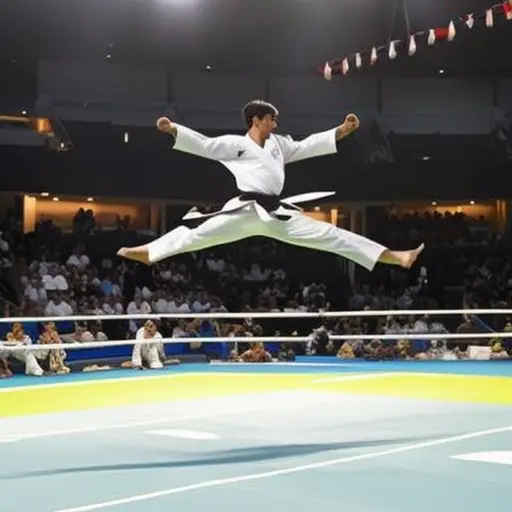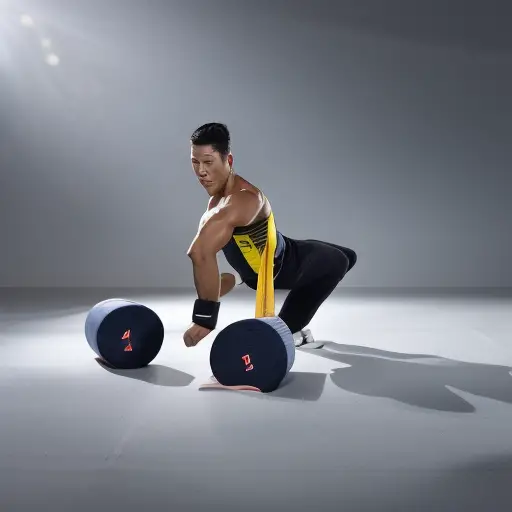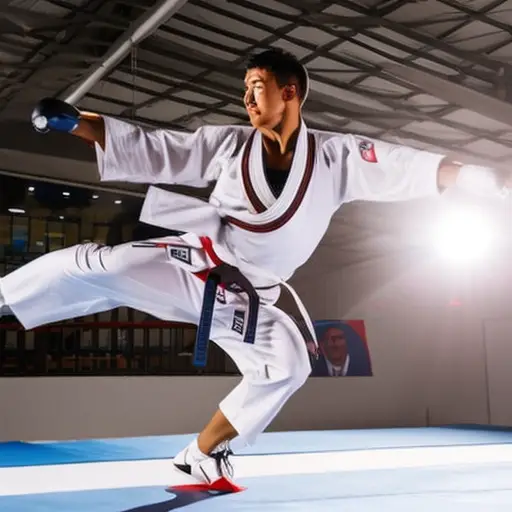Secrets to Perfecting the Side Kick

Discover the hidden artistry of the side kick, likened to a graceful dancer’s pirouette, as we unveil the secrets to perfecting this powerful martial arts technique.
This concise guide will delve into the intricate mechanics of the side kick, while offering expert advice on developing flexibility, enhancing hip rotation, and strengthening core and leg muscles.
Master the art of balance, timing, and execution, as well as advanced variations, to elevate your martial arts prowess to new heights.
Understanding the Mechanics
One of the key aspects to mastering the side kick is understanding the intricate mechanics involved in its execution. The mechanics of the side kick are essential to delivering a powerful and accurate strike. When performed correctly, the side kick can be a devastating weapon in martial arts and self-defense.
To execute a side kick effectively, it is crucial to start with a proper stance. The kicking leg should be chambered, with the knee raised towards the chest. As the kick is initiated, the hips rotate in the direction of the target, generating power. The kicking leg extends straight, driving the heel towards the target, while the supporting leg provides stability and balance.
Common mistakes in the side kick often stem from improper technique. One frequent error is not fully rotating the hips, resulting in a weak and ineffective kick. Another mistake is failing to maintain proper body alignment, causing the kick to veer off target. Additionally, a lack of chamber in the knee can compromise the power and accuracy of the kick.
Mastering the mechanics of the side kick requires discipline and attention to detail. By understanding and correcting common mistakes, practitioners can enhance the power, speed, and precision of their side kicks, ultimately improving their overall martial arts performance.
Developing Flexibility and Range of Motion
To perfect the side kick, there are three key aspects to focus on: flexibility, kicking power, and warming up.
First, developing flexibility and range of motion is crucial. Stretching techniques are essential in improving flexibility, as they allow for a greater range of motion in the legs and hips. By regularly stretching the muscles involved in the side kick, such as the hamstrings and hip flexors, you can gradually increase your flexibility and improve the execution of the kick.
Next, increasing kicking power is important for a powerful and effective side kick. This can be achieved through exercises that target the muscles involved in the kick, such as the quadriceps and glutes. Squats, lunges, and other leg strengthening exercises can help build the necessary strength and power for a strong side kick.
Lastly, warming up before practice or training is essential. Warming up helps to prepare the body for the physical demands of kicking and reduces the risk of injuries. Dynamic stretches, light cardio exercises, and joint mobilization movements can be included in the warm-up routine to increase blood flow, loosen up the muscles, and improve overall performance.
Stretching Techniques for Flexibility
The proper technique for developing flexibility and range of motion begins with a thorough understanding of the body’s limitations and potential.
To enhance flexibility, various stretching techniques can be employed. Two effective methods include dynamic stretching and partner stretching. Dynamic stretching involves moving parts of your body through a full range of motion, while partner stretching involves using a partner’s assistance to deepen the stretch.
These techniques not only increase flexibility but also improve muscle elasticity and joint mobility. Regular practice of dynamic stretching and partner stretching can lead to increased flexibility, reduced risk of injury, and improved performance in physical activities.
Increasing Kicking Power
By implementing targeted flexibility exercises and expanding the range of motion, practitioners can significantly amplify their kicking power. Power building exercises play a crucial role in increasing the force and speed behind a kick. These exercises focus on strengthening the muscles involved in kicking, such as the quadriceps, hamstrings, and glutes.
Squats, lunges, and plyometric exercises are effective in building lower body strength, which translates to more power in kicks. Additionally, incorporating effective kicking techniques, such as proper body alignment, hip rotation, and follow-through, can optimize the force generated during a kick. By combining power building exercises with correct technique, practitioners can enhance their kicking power and deliver stronger, more impactful strikes.
Transitioning into the next section on the importance of warm-up, it is crucial to adequately prepare the muscles and joints before engaging in intense kicking training.
Importance of Warm-Up
A thorough warm-up is essential in developing flexibility and range of motion, allowing practitioners to achieve optimal performance and reduce the risk of injury. Dynamic stretching is an important component of a warm-up routine as it helps to increase blood flow, warm up the muscles, and improve joint mobility. By incorporating dynamic stretches such as leg swings, arm circles, and torso twists, practitioners can effectively prepare their bodies for the physical demands of side kicks.
Preventing injuries is another crucial aspect of warm-up exercises. By gradually increasing the intensity of the warm-up, practitioners can reduce the risk of muscle strains, sprains, and other common injuries. Additionally, a warm-up allows individuals to mentally prepare for the training session, enhancing focus and concentration.
Mastering Foot Placement and Alignment
Mastering foot placement and alignment is crucial in perfecting the side kick. Correct foot positioning ensures stability and power.
Proper body alignment enhances technique and minimizes the risk of injury.
Correct Foot Positioning
The key to achieving a perfect side kick lies in the precise placement and alignment of the foot. Proper foot positioning ensures a strong and effective kick while minimizing the risk of injury. Here are some footwork techniques to master for correct foot placement:
-
Align the foot with the target: Position your foot so that it is aligned with the target you intend to strike. This will maximize the impact and accuracy of your side kick.
-
Maintain a stable base: Keep your supporting foot grounded and stable, distributing your weight evenly to maintain balance and power.
-
Avoid turning the foot inward: Turning the foot inward can lead to instability and decrease the effectiveness of the kick.
-
Keep the toes flexed: Flexing the toes helps to maintain a solid, powerful connection with the target.
Proper Body Alignment
To achieve optimal side kick performance, proper body alignment is essential, as it ensures correct foot placement and alignment. When executing a side kick, the body should be aligned in a straight line, with the hips and shoulders facing forward. This alignment allows for maximum power and stability during the kick.
Common mistakes in body alignment include leaning too far forward or backward, which can result in loss of balance and power. Additionally, improper alignment of the supporting leg can lead to instability and decreased kicking power. It is important to maintain a strong core and engage the muscles of the standing leg to ensure proper body alignment.
Enhancing Hip Rotation and Torque
Improving the efficiency of hip rotation and torque is crucial for optimizing the power and effectiveness of the side kick. By incorporating specific hip strengthening exercises and rotational power techniques, martial artists can enhance their kicking abilities and deliver devastating side kicks.
Here are some key strategies to enhance hip rotation and torque:
-
Plyometric exercises: Incorporate explosive movements such as jump squats and box jumps to develop explosive power in the hips. These exercises improve muscle strength and enhance the ability to generate rotational force.
-
Medicine ball exercises: Perform exercises like Russian twists and overhead throws with a medicine ball to engage the core muscles and promote rotational power. These exercises also improve stability and balance, essential for executing powerful side kicks.
-
Resistance band exercises: Utilize resistance bands to add resistance to hip abduction and adduction movements. These exercises target the hip muscles and improve the ability to generate rotational force.
-
Dynamic stretching: Prioritize dynamic stretching exercises that target the hip muscles, such as leg swings and hip circles. These exercises help to improve flexibility, range of motion, and prepare the hips for powerful kicks.
Incorporating these hip strengthening exercises and rotational power techniques into training routines will enhance hip rotation and torque, enabling martial artists to deliver powerful and effective side kicks.
Strengthening Core and Leg Muscles
In addition to plyometric exercises and resistance band exercises, incorporating core strengthening exercises along with leg muscle training is essential for maximizing the power and stability of the side kick. Functional training that targets the core and leg muscles will not only improve the strength but also enhance the overall performance of the kick.
To strengthen the core, exercises such as planks, Russian twists, and bicycle crunches can be incorporated into the training routine. These exercises engage the abdominal muscles, obliques, and lower back, which are crucial for maintaining a stable and balanced body position during the side kick. Additionally, leg muscle training exercises such as squats, lunges, and calf raises can be included to develop the necessary strength and endurance.
Plyometric exercises should also be included in the training regimen to enhance explosive power in the legs. Exercises like squat jumps, box jumps, and lateral bounds can help improve the speed and force generation required for an effective side kick. These exercises engage the fast-twitch muscle fibers, which are responsible for quick and powerful movements.
Improving Balance and Stability
Enhancing balance and stability is crucial for achieving optimal performance in executing the side kick. Improving coordination and enhancing proprioception are key factors in developing the necessary control and precision for executing this powerful technique.
Here are some strategies to improve balance and stability:
-
Engage in balance exercises: Incorporate exercises such as standing on one leg, using a balance board, or practicing yoga poses like the tree pose. These exercises challenge your stability and help improve your body’s ability to maintain balance.
-
Strengthen your core muscles: A strong core provides a solid foundation for balance and stability. Include exercises like planks, Russian twists, and leg raises to strengthen your core muscles, including the abdominals, obliques, and lower back.
-
Practice proprioceptive drills: Proprioception refers to the body’s ability to sense its position in space. Incorporate drills that challenge your proprioceptive abilities, such as balancing on unstable surfaces like a foam pad or using a wobble board.
-
Incorporate dynamic movements: Perform exercises that involve dynamic movements, such as lunges, squats, and jumping exercises. These movements not only improve your coordination but also enhance your overall stability.
Perfecting Timing and Execution
With careful attention to timing and precise execution, one can master the art of the side kick. Timing is crucial in delivering a powerful and effective side kick. It involves coordinating the movement of your legs and body with the opponent’s position and actions. The key to improving speed lies in the ability to anticipate and react swiftly to your opponent’s movements. By training your reflexes and practicing drills that focus on timing, you can enhance your ability to execute a side kick with lightning speed.
In addition to timing, perfecting the chamber position is essential for a successful side kick. The chamber position refers to the moment when your knee is bent and pulled towards your chest, preparing for the kick. It is important to maintain a tight and controlled chamber position to generate maximum power and stability. By strengthening your hip flexors and practicing proper form, you can enhance your chamber position and improve the overall execution of your side kick.
As we delve deeper into the secrets of perfecting the side kick, we will now explore incorporating advanced techniques and variations to further enhance your martial arts skills.
Incorporating Advanced Techniques and Variations
By delving into the realm of incorporating advanced techniques and variations, martial artists can elevate their side kick to new levels of precision and effectiveness. Advanced kicking techniques allow practitioners to unleash the full potential of their side kicks, while creative combinations add an element of surprise and unpredictability to their arsenal.
Here are some key ways to incorporate advanced techniques and variations into your side kick:
-
Jumping Side Kick: This powerful variation adds height and distance to your kick, enabling you to strike opponents from unexpected angles. Jumping side kicks require explosive leg strength and impeccable timing, making them a formidable weapon in any martial artist’s repertoire.
-
Spinning Side Kick: This dynamic technique involves a full spin before executing the kick, generating tremendous rotational force and delivering a devastating blow. Spinning side kicks require exceptional balance, coordination, and control, showcasing the martial artist’s mastery over their body.
-
Sliding Side Kick: By sliding across the floor before launching the kick, the sliding side kick allows for increased speed and momentum, catching opponents off guard. This technique requires precise footwork and timing, making it a valuable tool in close-quarters combat.
-
Switching Side Kick: The switching side kick involves swiftly changing your stance mid-kick, catching opponents by surprise and exploiting their blind spots. This technique demands quick reflexes and adaptability, showcasing the martial artist’s ability to seamlessly transition between different movements.
Incorporating advanced kicking techniques and creative combinations into your side kick repertoire can significantly enhance your effectiveness as a martial artist. These techniques not only showcase your skill and mastery but also give you a competitive edge in combat situations.
Frequently Asked Questions
What Are Some Common Mistakes to Avoid While Performing a Side Kick?
When performing a side kick, it is important to avoid common mistakes that can hinder balance and technique. By focusing on maintaining proper alignment, engaging core muscles, and practicing proper form, one can improve their side kick execution.
How Can I Increase the Power and Speed of My Side Kick?
To increase the power and speed of a side kick, focus on increasing flexibility in the hip and leg muscles through regular stretching exercises. Additionally, perfecting proper technique, such as pivoting on the supporting foot and engaging the core, can enhance the kick’s effectiveness.
Are There Any Specific Warm-Up Exercises That Can Help Prepare My Body for Side Kicks?
Warm up routines and stretching techniques are essential for preparing the body for side kicks. By incorporating dynamic stretches and exercises that target the lower body, such as leg swings and lunges, you can enhance flexibility and reduce the risk of injury.
Can Side Kicks Be Effective for Self-Defense Situations?
Side kicks can be highly effective in self-defense situations due to their range, power, and ability to target vulnerable areas. Techniques such as front, roundhouse, and hook kicks can be utilized to defend against various types of attacks, providing a strategic advantage.
What Are Some Drills or Exercises That Can Help Me Improve the Height of My Side Kick?
To improve the height of your side kick, incorporate drills such as leg raises, dynamic stretching, and plyometric exercises. Additionally, focus on proper technique, engaging the core, and gradually increasing flexibility and strength in the hip and leg muscles.
Conclusion
In conclusion, perfecting the side kick requires understanding the mechanics. This involves developing flexibility and range of motion. Additionally, mastering foot placement and alignment is crucial. Enhanced hip rotation and torque are also important factors. To achieve a flawless side kick, strengthening core and leg muscles is essential.
Improving balance and stability plays a significant role in executing a perfect side kick. Timing and execution should also be perfected. Lastly, incorporating advanced techniques and variations can take one’s side kick to the next level.
As the saying goes, ‘Practice makes perfect.’ By diligently honing these skills, one can achieve a flawless side kick and become a formidable force in martial arts.





